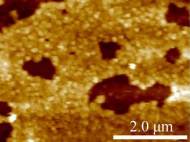Successful tests of plastic antibodies used to treat living animals
 Scientists reported the first evidence that a plastic antibody works in the bloodstream of a living animal, opening up the possibility of plastic antibodies (synthetic polymer nanoparticles) being custom tailored to fight everything from viruses and bacteria to the proteins that cause allergic reactions that to plant pollen, house dust, certain foods, poison ivy, bee stings and other substances.
Scientists reported the first evidence that a plastic antibody works in the bloodstream of a living animal, opening up the possibility of plastic antibodies (synthetic polymer nanoparticles) being custom tailored to fight everything from viruses and bacteria to the proteins that cause allergic reactions that to plant pollen, house dust, certain foods, poison ivy, bee stings and other substances.
The synthetic polymer nanoparticles are also known as molecularly imprinted polymeric (MIP) nanoparticles because they are made using an approach called molecular printing. In the report, the researchers refer to previous research in which they developed a method for making plastic nanoparticles, barely 1/50,000th the width of a human hair, that mimic natural antibodies in their ability to latch onto an antigen. That antigen was melittin, the main toxin in bee venom.
The scientists mixed melittin with small molecules called monomers, and then started a chemical reaction that links those building blocks into long chains, and makes them solidify. When the plastic dots hardened, the researchers leached the poison out. That left the nanoparticles with tiny toxin-shaped craters.
Chemists Kenneth Shea and Yu Hoshino of the University of California, Irvine, (UCI), working with the group of Naoto Oku at the University of Shizuoka, in Japan, injected a lethal dose of melittin into mice. Animals that then immediately received an injection of the melittin-targeting MIP nanoparticles showed a significantly higher survival rate than those that did not receive the nanoparticles.
Although the MIP nanoparticles have previously been shown to target melittin in vitro with an affinity and selectivity comparable to those of natural antibodies, this is the first time the synthetic antibodies have been used in living animals.
The researchers determined the biodistribution of both the melittin and the MIP nanoparticles by fluorescence imaging of dye-labeled nanoparticles and melittin. The MIP nanoparticles and their targeted melittin accumulated in the same cells in the liver, suggesting that the nanoparticles sequester the toxin and that the complex is then cleared from the body by the liver.
“This opens the door to serious consideration for these nanoparticles in all applications where antibodies are used,” said Shea.










Such an informative post shared here. It is great to read this information.